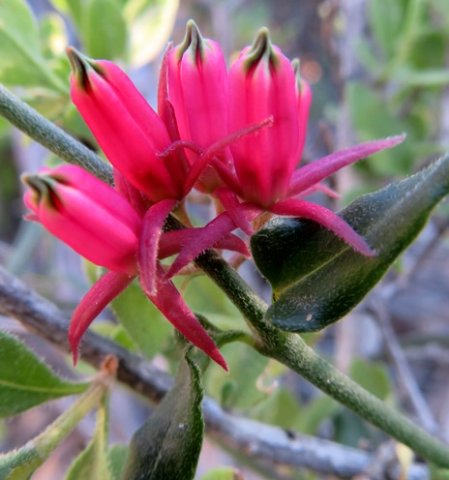Microloma

Author: Ivan Lätti
Photographer: Thabo Maphisa
Microloma is a genus of climbing perennials growing twining, evergreen branches, or rigid to spinescent shrublets. They form part of the Apocynaceae or milkweed family and are commonly known as wax creepers.
The plants usually grow to about 1 m in height. They are sometimes hairy, while old plants may develop corky bark. The plant sap is clear, the roots fibrous or spindle-shaped.
The opposite and stalked leaves are triangular or linear in shape, sometimes eared at the base and pendulous or erect in orientation. The mostly small blades may be fleshy or leathery and sometimes hairy. Some plants tend to lose their leaves in summer.
The finely hairy inflorescences grow above or below the leaf axils, comprising from one to fifteen flowers. The lance-shaped sepals are divided to near the base, hairy and green or pinkish red in colour.
The corolla tube is urn-shaped or tubular to bell-shaped and five-angled with prominent ridges. The corolla lobes are rounded to triangular, usually folded inwards along their midribs and twisted. In most cases the lobe tips fold in over the flower mouths, closing them completely; spreading lobes are rare. Corolla colours include green, greenish yellow, orange, red and pink.
Some species also have coronas, consisting of five rounded lobes emerging inside the corolla tube and alternating with patches of golden yellow hairs. The anthers have membranous appendages pressed against the style head and tipped with hairs. The pollinia (coherent masses or sacs of pollen grains) are long and flat, hanging down.
Pollination is done by sunbirds that pierce the closed, nectar-rich flowers with their long, sharp beaks. The pollen sacs accumulate on the sunbird tongues and pollen is distributed as the birds visit consecutive flowers to satisfy their hunger. This constitutes a specialised bird pollination adaptation sustaining the flower species while feeding the birds.
The fruit follicles are spindle-shaped, hairless and pendulous, tapering to long, narrow tips.
There are eleven species of Microloma, all found in southern Africa, mostly in arid regions. Microloma plants are often heavily browsed, making an abundance of these plants an indication of well-managed veld.
The plant in picture is Microloma sagittatum (Leistner, (Ed.), 2000; Curtis-Scott, et al, 2020; Vlok and Schutte-Vlok, 2015; Manning, 2007).

